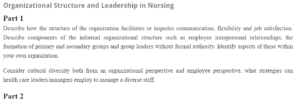Organizational Structure and Leadership in Nursing
Part One: Organizational Structure
There is a continuing debate as to the type of organizational structure that promotes healthy and open communication. Whereas some individuals claim that a clear hierarchy that has a direct chain of command reduces confusion by outlining the individual(s) in charge, others claim that a flat organizational structure that has a few lines of authority with a leader having direct communication with practically every employee facilitates a free flow of information and ideas. There is no particular organizational structure that fits every situation. However, a strict hierarchy structure can be problematic in terms of open information and communication, as well as flexibility in an organization that thrives on risk-taking, imagination, and creativity (Adubato, 2020). Given a lack of autonomy, employees’ satisfaction is reduced. Flat organizations could facilitate more open communication but could also generate chaos in terms of information overload, particularly if the organization’s size is big. However, Johnson (2019) claims that most flexible organizations are based on flat structures that promote employees’ self-reliance, distribute decision-making powers to the employees, enhance the organization’s responsiveness, and enhance employees’ job satisfaction. Hire our assignment writing services in case your assignment is devastating you.
Informal organizations do not have a structure, formal rules, or designated roles but thrive when leadership communicates desired advantages. Such organizations thrive on interpersonal relationships due to the interdependence among the members. This is common in my organization as well since everyone needs the other in order for the organization to function properly. However, group leaders and groups with no formal authority could have trouble since the organization has actual operating relationships that are not prescribed in formal organizations. To manage a diverse staff, it is important to employ diversity training in which individuals are trained on cultural competence and awareness to facilitate employee relations (Udod & Racine, 2019). Healthcare leaders or managers should also implement communication styles that allow for a free flow of information and teamwork to enhance social contact.
References
Adubato, S. (2020). Organizational structure impacts communication style. Retrieved from https://www.stand-deliver.com/columns/communication/1079-organizational-structure-impacts-communication-style.html
Johnson, S. (2019). Flexible organizational structure. https://yourbusiness.azcentral.com/flexible-organizational-structure-12649.html
Udod, S., & Racine, L. (2019). Leadership and influencing change in nursing. https://leadershipandinfluencingchangeinnursing.pressbooks.com/chapter/chapter-2-diversity-in-health-care-organizations/
Part Two: Leadership in Nursing
Charismatic leadership is one that is reliant on the persuasiveness and charm of the leader. Charismatic leaders are considered skilled communicators who are both verbally eloquent and communicate emotionally and deeply to followers. According to Hofmann (2017), charismatic leadership is a kind of leader-follower relationship that arises mostly during an economic, political, social or religious crisis, especially when other kinds of leadership are considered incapable of resolving the turmoil. On the other hand, legitimate power is one that comes from being in a position of power in the organization, such as being a key member or boss. This comes when employees recognize the individual’s authority. In my profession, there was a time when a client under my care developed some complications while at the hospital just a day before his discharge. Since more hospital beds were required, my supervisor insisted on the patient’s discharge despite my advice to allow the patient to stay longer. Even though there were no major effects on the patient after his discharge, my supervisor abused his power, endangering the patient’s life, even though it is true that more beds were needed. I like to use my power to influence people toward achieving a common goal, making use of teamwork and shared decision-making to ensure that everyone feels included and committed to the organization.
To increase my power base, I will strive to enhance my self-awareness since Huston (2008) claims that individuals who understand their beliefs and values are more conscious of why and how they make decisions. Becoming an expert and improving my skills and knowledge can also enhance my power base. Lastly, seeking mentoring relationships and role models, particularly at work, can help increase my competency as a leader. To help mobilize the power of healthcare professionals, it will be important to employ shared decision-making and encourage a multi-disciplinary team with well-defined roles for every individual, emphasizing the importance and autonomy of every member and ensuring individual accountability.
References
Hofmann, D.C. (2017). Charismatic leadership. In: Poff D., Michalos A. (eds) Encyclopedia of Business and Professional Ethics. Springer, Cham. https://doi.org/10.1007/978-3-319-23514-1_23-1
Huston, C. J. (2008). Eleven strategies for building a personal power base. Nursing Management, 39(4), 58-61.
ORDER A PLAGIARISM-FREE PAPER HERE
We’ll write everything from scratch
Question
Organizational Structure and Leadership in Nursing
Part 1
Describe how the structure of the organization facilitates or impedes communication, flexibility, and job satisfaction. Describe components of the informal organizational structure, such as employee interpersonal relationships, the formation of primary and secondary groups, and group leaders without formal authority. Identify aspects of these within your own organization.

Organizational Structure and Leadership in Nursing
Consider cultural diversity both from an organizational perspective and employee perspective, what strategies can health care leaders/managers employ to manage a diverse staff.
Part 2
Compare/ contrast the following: legitimate, charismatic. Reflect upon an experience in your professional career in which you feel there was an inappropriate use of power to influence a situation or outcome. In addition, assess your use of power within your professional role or student role. Discuss how you will use strategies to increase your personal power base and also how in turn you will help mobilize the power of health care professionals.
APA format, 4 academia references (2 for each part)

